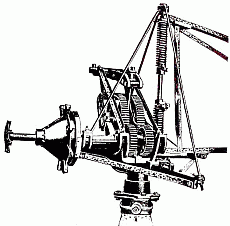


This windmill is one of the great success stories in the history of the farm style pumping windmill, and in its day sold in great numbers throughout the world. The model in various sizes is surprisingly common in Western Australia and can be found on many a rubbish tip, or lying forgotten at the bottom of an old tower. For the enthusiast - if you find an old windmill tower, which is well galvanised, braced with twisted wire and uses steel which is rolled into a 60 degree angle rather than formed with a sharp corner at 90 degrees, then there is a fair chance this is a SAMSON. Look down the well, check any bulldozed mounds and go for a tour of the area.
The company was formed in 1881, in Freeport, Illinois, USA, although its principal Daniel C. STOVER had been manufacturing and inventing various machinery from the 1860's. Windmills were not added to the company production list until 1883.
Daniel STOVER together with his brother, had patented a windmill in 1872, but sold the manufacturing rights. This windmill, the STOVER SOLID WHEEL was also sold in Australia during the 1880's by 'Geo P. HARRIS SCARFE' and possibly others, under the name of the OLD RELIABLE FREEPORT windmill.
Earlier STOVER MANUFACTURING & ENGINE COMPANY windmills, such as the all metal, and the metal & wood versions of the IDEAL windmill were also available in Australia.
This particular design first saw the light of day about 1898 when a small 6 foot wind wheel experimental model was made and placed on a tower at the factory for evaluation. Then in 1899 a 20 ft model was developed and several prototypes were erected in Texas atop 400 and 698 feet deep wells, using 4 inch pump barrels. The first commercially made version became available in 1900.
SAMSON windmills were available with 4.5, 6, 8, 10, 12, 14, 16, 18 and 20 foot wind wheels. 6, 8 and 10 foot models have so far been located in Western Australia. Considering the design of the example here, the particular production date would appear to be from the period 1904 when the pitman design changed and 1920 when roller bearings were provided. Manufacture ceased c1925.
One New Zealand company P. & D. DUNCAN, liked this model so much that they made a copy called the HERCULES.
The model on display in the Morawa museum is made up from parts donated by several local farmers.